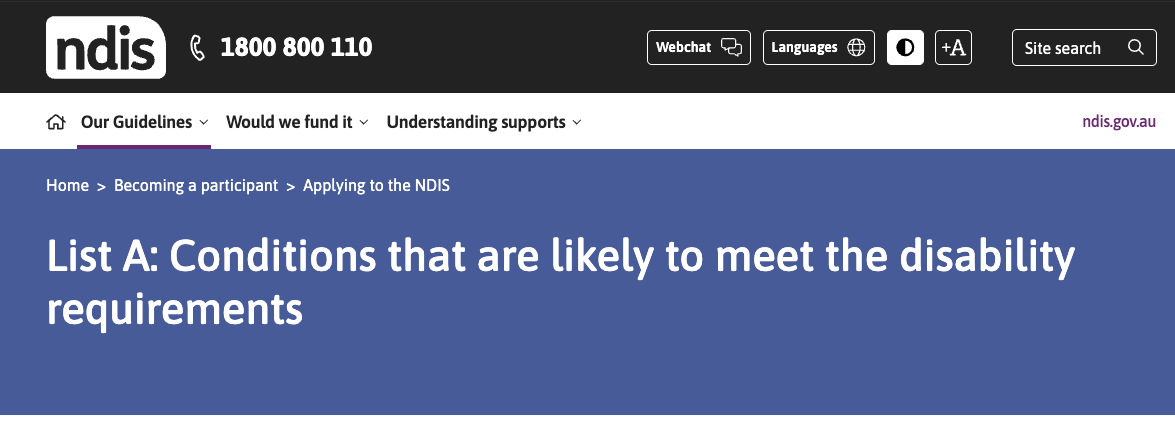The NDIS is evolving in 2025, and many families are asking what it means for everyday supports. This plain-English guide summarises the key updates to support lists, pricing and plan structure, the new needs assessment pathway, foundational supports, and Thriving Kids, then explains who is affected and when. We also highlight what has not changed, and link to official sources so you can check the details for your situation.
NDIS Changes at a Glance
- Clear “support lists” are now in force (since 3 Oct 2024): participants can only use NDIS funds for items on the approved lists; there’s also a list of items that cannot be funded, plus a replacement rule in limited cases. New and reviewed plans now show total budgets, funding components and funding periods.
- Pricing updates took effect 1 July 2025: the 2025–26 Pricing Arrangements & Price Limits (PAPL) apply, including an update that the early childhood approach now covers children up to 9 years (was 7).
- New needs assessments are being built now: the NDIA has licensed the I-CAN v6 tool to underpin a simpler, fairer assessment focused on support needs (not just impairments). Roll-out is planned from mid-2026, with accredited assessors; early media reports say many applicants won’t need to collect costly medical reports.
- Foundational supports (outside the NDIS) are slated to start in phases from 2025, but governments have signalled delays into late 2025 as details are finalised.
- Thriving Kids (for children ≤8 with mild–moderate needs) is scheduled to begin 1 July 2026 with $2b Commonwealth funding; it will scale community-based early supports while children with permanent and significant disability remain on the NDIS.
- Stronger integrity & ID checks: NDIS providers are transitioning from PRODA to myID + RAM during 2025 to better protect participant data; fraud taskforce work continues.
- Eligibility itself has not changed: the 2024 amending Act didn’t change who can access the NDIS (still for people with a permanent and significant disability or early intervention requirements).
What Exactly is Changing & How it Affects Families
What you can buy with your plan: the support lists
What changed: From 3 Oct 2024, there’s a formal definition of “NDIS supports” plus three lists: what’s funded, what’s not funded, and a replacement list for specific substitutions. Plans also show total amounts, components, and funding periods.
What this means for you:
- Less grey area at checkout time (fewer surprises/declines).
- Some items people used to claim (e.g., lifestyle or non-evidence-based items) are now clearly not fundable. For a helpful plain-English news explainer, see ABC’s summary.
How plans are structured & released
What changed: Under the 2024 law changes and system updates, plans can be built and shown by funding components and funding periods (e.g., monthly/quarterly release), which supports steadier spending and reduces mid-year shortfalls.
What this means for you:
- Expect your new or reviewed plan to display clearer budget groupings and timing windows.
- Providers and plan managers will align scheduling and invoices to these periods.
Prices & limits for 2025–26
What changed: The 2025–26 PAPL came into effect 1 July 2025. It also reflects policy updates such as early childhood up to 9 years and strengthened guidance on provider conflicts of interest.
What this means for you:
- Check the PAPL if a quote or invoice seems high; it sets maximum price limits for many supports. (Participants can negotiate lower prices)
A new assessment pathway (I-CAN v6)
What changed: The NDIA is moving to an assessment centred on support needs using I-CAN v6, developed with the Centre for Disability Studies and University of Melbourne. Roll-out is planned from mid-2026 with accredited assessors.
What this means for you:
- Assessments aim to be more consistent and less paperwork-heavy. Government/media guidance indicates many applicants won’t need to source new medical reports, addressing a major cost barrier; advocacy groups are urging strong transparency and person-centred practice.
Foundational supports & Thriving Kids
What changed/coming: Governments agreed to build foundational supports, community-based, evidence-informed help for people who don’t need individual NDIS packages. Officially, phased implementation starts from July 2025, but reporting suggests slippage into late 2025 while intergovernmental work is finalised.
Thriving Kids (from 1 July 2026): A national program focusing on children 8 and under with mild–moderate developmental delay and autism, with $2b Commonwealth funding, to provide earlier, local supports (GPs, child and family health, early learning, schools, phone/digital) outside the NDIS. Children with permanent and significant disabilities stay on the NDIS.
What this means for you:
- Families with younger children and milder needs may be directed to foundational supports/Thriving Kids for early, evidence-based help.
- If your child’s disability is permanent and significant, NDIS eligibility remains.
Integrity & identity verification (myID + RAM)
What changed: From Aug 2025, providers are transitioning from PRODA to myID (Digital ID) and RAM to strengthen identity checks and protect participant data. Fraud Fusion Taskforce work continues, with regular enforcement updates.
What this means for you:
- Expect providers to upgrade login/portal processes; this should reduce risk of misuse of funds and identity fraud.
Psychosocial disability (mental health)
What’s evolving: The NDIS Review recommends a new, personal-recovery-oriented approach for psychosocial disability within the NDIS, and broader mental-health reforms for people with severe mental illness who are not NDIS participants. Government is still working through the details.
What this means for you:
- Expect changes in how supports are planned and measured for psychosocial disability over the next 1-2 years, with a stronger focus on recovery and episodic needs.
What Hasn’t Changed: Eligibility Remains the Same
The 2024 amendments did not alter who can access the NDIS. Eligibility is still based on having a permanent and significant disability that affects everyday functioning, or meeting early intervention requirements. If your needs and circumstances are unchanged, your access to the NDIS is unchanged by these updates.
Dates to watch
- Now – Support lists and new plan display rules apply.
- 1 July 2025 – 2025–26 pricing in effect; ECEI coverage up to age 9.
- Late 2025 – Foundational supports planning continues; start likely staggered.
- From mid-2026 – New needs assessments begin rolling out (I-CAN v6).
- 1 July 2026 – Thriving Kids first services expected; ramp-up over 12 months.
Practical Steps for Families
- Check your plan against the support lists before buying. If in doubt, ask the provider to reference the list item in your service agreement/quote.
- Know your funding periods. If your plan releases funds monthly/quarterly, schedule services to match so you don’t under- or over-spend mid-plan.
- For young children: if you hear about “foundational supports” or “Thriving Kids”, know it’s designed to add earlier, local help for mild–moderate needs, not to remove NDIS from kids with permanent and significant disability.
- Keep simple evidence. Even as assessments evolve, keep reports/notes that clearly link supports to functional needs and goals (this helps at plan reassessment).
- Stay scam-aware. Only share plan details with trusted providers and report suspected fraud.
Community Pulse: What People are Saying
Here’s a quick read on the public conversation (forums, advocacy groups, and recent reporting). It’s not scientific, but it captures the main themes we’re seeing right now.
The Big Concerns
- Support lists anxiety. Many participants and carers worry the “in/out” rules are too rigid or unfair, and that useful items are being excluded. Advocacy surveys report widespread concern about the new approach.
- Plan cuts and appeals stress. Reporting shows a sharp rise in tribunal challenges and a perception of an adversarial process, which families describe as daunting.
- New assessments (I-CAN v6): hope + hesitation. People welcome less paperwork, but worry about transparency and whether a tech-led tool could lead to “tick-box” decisions.
- Foundational supports timing. Families fear delays and mixed hand-offs between governments; they want guarantees no one will fall through the cracks during roll-out
- General scepticism in some public forums. You’ll also see posts alleging rorts or waste, which fuels pressure for tighter rules and oversight.
Positives people call out
- Clearer boundaries. The lists and substitution rules reduce grey areas and make it easier to check if something’s fundable before buying.
- Less costly evidence (if delivered well). New needs assessments are slated to reduce reliance on expensive medical reports, seen as a relief by many.
- Integrity moves. Stronger ID checks and fraud crackdowns are generally viewed as necessary to protect participants and the scheme.
Official Resources
- Changes to NDIS legislation (support lists, new rules, plan display).
- PAPL 2025–26 & Support Catalogue.
- New assessment tool (I-CAN v6) announcements.
- Foundational supports roadmap: Dept of Health, Disability & Ageing.
- Thriving Kids fact sheet (program, dates, cohort): Dept of Health, Disability & Ageing.
- Strengthening provider identity (myID/RAM).
- NDIS Review – recommendations.
- ABC explainer of the Oct 2024 changes.
Where We Can Help
We know the recent NDIS changes can feel confusing. If you’d like some help making sense of your plan and options our Support Coordination team can:
- sanity-check purchases against the support lists,
- align your services with funding periods to reduce gaps,
- prepare simple, goal-linked notes for reassessments, and
- connect families of young children to the right pathway, so no one falls through the cracks.





